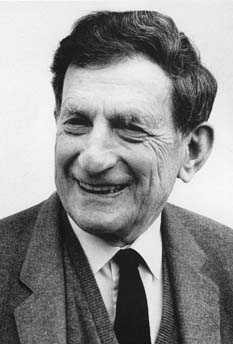
Imagine a child whose ambition is to show that all the laws of the universe have the same source and that all things are interconnected, including the nature of mind. Moreover, this child has a special talent for solving complex problems: he sees himself as a microcosmic reflection of the universe as a whole, and by studying his own thoughts and feelings he comes to a deeper understanding of the workings of nature. This is how David Bohm was described as a young teenager, and it helps explain how he was able to make such significant contributions to physics, philosophy, psychology, and the study of consciousness.
But there was another side to the scientist which could be seen as the driving force in his life. It was his deep concern for the plight of humanity: the fragmentation of heart and mind that leads to hatred, cynicism, irrationality, and war. From an early age his aspiration was to give people a holistic understanding of life. Once this fundamental holism was really understood, human nature would change, and people would act according to the welfare of the whole.

This extraordinary aspiration is especially intriguing. It sustained a lifetime of profound inquiry, and gave expression to an unusual form of compassion which often appeared to have a cosmic scope. What would it lead him to understand? How far-reaching are the implications, and what do they mean for society at large?
To begin with, remarkable things happened when Bohm's compassion turned to the processes of nature. There were times when he felt he was actually sharing the experience of natural phenomena. He saw the workings of the universe as living beings. Whatever aspect of nature he deeply studied, no matter how large or small, he could somehow share its life as an integral part of the whole. So every entity was part of a larger whole, and each was a manifestation of the entire universe.
The implications of such a vision are staggering. It means the universe has infinite levels while still acting like one indivisible unit, that higher levels determine the nature of what exists at lower levels, and that everything is intimately interconnected as an organic whole. What happens in one locality affects what is happening on that entire level, and sets up infinitely complex chains of causation above and below -- so complex and imperceptible that nature can often have the appearance of chaos. But regardless of what we perceive, there is always a deeper order.
This kind of understanding eventually led to Bohm's theory of the "implicate order." Whatever order we perceive is only on the surface of reality, the explicate order. Mechanical causes and effects, the appearance of distance and separation, and even the nature of time and space -- are all enfolded in the implicate order of a cosmic holomovement, the flowing processes and transformations of an organic whole. This holomovement is infinite in its potential and gives rise to everything within and beyond our understanding, including consciousness and human observers themselves.
To illustrate the nature of the implicate order, Bohm compared it to the process of a holograph. Every fragment of a holographic plate, regardless of its size, contains "enfolded" information about the entire image. When these fragments are illuminated, every one can reproduce the total picture. Ultimately, a single point on the plate could still produce the complete illusion of three-dimensional depth, distance, and separation -- whereas the real information would be enfolded all together in every point of the plate.
As complicated as this seems, Bohm saw it as only a "shadow" of what the implicate order meant to him. His realizations give intimations of an infinite hierarchy of ever deeper implicate and superimplicate orders, each one enfolded in the level that underlies it. And these flow endlessly into the unknowable ground of being.
One of the main virtues of Bohm's all-embracing vision of life is that it can free us from the old restrictive paradigms of science, so that the possibilities for creative innovation are endless. His ideas have opened new avenues of thought in a multitude of disciplines, and have made it possible for a great many to gain insight into new fields of study. But most importantly, Bohm's vision has a great potential to change the way people think and act. It transfers the focus of our attention away from limitations and separation, and directs our minds toward the infinite potential of interconnectedness and wholeness.
If we consider what David Bohm aspired to as a child and compare it to how much he succeeded in doing, it is truly a remarkable achievement. But what about our own aspirations? Of all the things we may want to accomplish, what would be our deepest desire? Are we not driven by the same urge to understand who we are and what life is all about? When faced with complex problems of any nature, do we not reflect them within our own thoughts and feelings? And in the depths of both heart and mind, are we not concerned about the plight of humanity?
Suppose we recognized our intimate connection with the whole of life. How precious it would be to see the workings of nature come alive. To feel the universe within us. To know that our thoughts and actions are important in affecting our surroundings. Imagine being able to access the level of consciousness that underlies all our thinking, and realizing that there is always a deeper order to the mind -- an infinite potential in which the entire universe is enfolded. Could each of us be like that single holographic point, capable of reproducing the entire cosmos within our being?